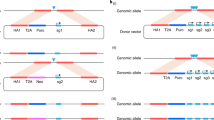Abstract
Super-unstable mutations occasionally appear either in natural populations of Drosophila melanogaster or in P-M hybrid dysgenesis. We found that they may be reproducibly obtained with a high frequency from crosses between males from the % MathType!MTEF!2!1!+-% feaafeart1ev1aaatCvAUfeBSjuyZL2yd9gzLbvyNv2CaerbuLwBLn% hiov2DGi1BTfMBaeXatLxBI9gBaerbd9wDYLwzYbItLDharqqtubsr% 4rNCHbGeaGqiVu0Je9sqqrpepC0xbbL8F4rqqrFfpeea0xe9Lq-Jc9% vqaqpepm0xbba9pwe9Q8fs0-yqaqpepae9pg0FirpepeKkFr0xfr-x% fr-xb9adbaqaaeGaciGaaiaabeqaamaabaabaaGcbaWaaubiaeqale% qabaWaaubiaeqameqaleaacaGGQaaaoeaacaWGHbGaam4raaaaa0qa% aiaadEhaaaaaaa!3A01!\[\mathop w\nolimits^{\mathop {aG}\nolimits^* } \] strain and females from the w aG* strain or its derivatives. Super-unstable mutations in the ocelliless, singed, white, yellow and other loci have been obtained. Each super-unstable mutation gives rise to a large family of new super-unstable mutations with a wide range of phenotypic expression. Mutations with the same phenotype often differ in the specificity of their potential for further mutation. As a rule, a super-unstable mutation is associated with a specific reversible mutation and paired alleles are formed in this way. Other mutations are usually irreversible, but new mutations of these may also form paired alleles. Active transposase encoded by transposable P elements is necessary to maintain super-instability. Finally, some preliminary molecular data are discussed which suggest that this type of super-instability is a result of interaction between P elements and a novel mobile element, designated as X.
Similar content being viewed by others

References
Demerec, M., 1927. The behavior of mutable genes. Proc. V Iternat. Congr. Genet., Berlin: 183–195.
Engels, W. R., 1979. Extrachromosomal control of mutability in Drosophila melanogaster. Proc. Natl. Acad. Sci. USA 76: 4011–4015.
Engels, W.R., 1989. P-element in Drosophila melanogaster, pp. 437–484 in Mobile DNA, edited by D. E., Berg and M. M., Howe. American Society for Microbiology, Washington, DC.
Engels, W. R., D. M., Johnson-Schlitz, W. B., Eggleston & J. A., Sved, 1990. High-frequency P element loss in Drosophila is homolog-dependent. Cell 62: 515–525.
Georgiev, P. G., S. L., Kiselev, O. B., Simonova & T. I., Gerasimova, 1990a. A novel transposition system in Drosophila melanogaster depending on the Stalker mobile genetic element. EMBO J. 9: 2037–2044.
Georgiev, P. G., S. L., Kiselev, O. B., Simonova & T. I., Gerasimova. 1990b. Mitomycin C induces genomic rearrangements involving transposable elements in Drosophila melanogaster. Mol. Gen. Genet. 220: 229–233.
Geyer, P. K., K. L., Richardson, V. G., Corces & M. M., Green, 1988. Genetic instability in Drosophila melanogaster: P-element mutagenesis by gene conversion. Proc. Natl. Acad. Sci. USA 85: 6455–6458.
Golubovsky, M. D., Y. N., Ivanov & M. M., Green, 1977. Genetic instability in Drosophila melanogaster: putative multiple insertion mutants at the singed locus. Proc. Natl. Acad. Sci. USA 74: 2973–2975.
Hawley, R. S., R. A., Steuber, G. H., Marcus, R., Sohn, D. M., Baronas, M. L., Cameron, A. E., Zitron & J. M., Chase, 1988. Molecular analysis of an unstable P-element insertion at the singed locus of Drosophila melanogaster: evidence for intracistronic transposition of a P-element. Genetics 119: 85–94.
Hirazumi, Y., 1971. Spontaneous recombination in Drosophila melanogaster males. Proc. Natl. Sci. Acad. USA 68: 268–270.
Kidwell, M. G., J. F., Kidwell & P. T., Ives, 1977. Spontaneous, non-reciprocal mutation and sterility in strain crosses of Drosophila melanogaster. Mutat. Res. 42: 89–98.
Kidwell, M. G., J. F., Kidwell & J. A., Sved, 1977. Hybrid dysgenesis in Drosophila melanogaster: A syndrome of aberrant traits including mutation, sterility, and male recombination. Genetics 86: 813–833.
Kidwell, M. G., 1986. P-M mutagenesis, pp. 59–82. In Drosophila: a Practical Approach, edited by D. B., Roberts. IRL Press, Oxford.
Lindsley, D. L. & E. H. Grell, 1968. Genetic variations of Drosophila melanogaster. Carnegie Inst. Washington Publ., N 627.
Nabirochkin, S. D., E. N., Nabirochkina & Gazarjan, 1987. Induction of an unstable mutation in Drosophila melanogaster by microinjection of DNA from oncogenic viruses into embryonic polar plasma. Genetika (in Russian) 23: 1847–1858.
Rio, D. C., F. A., Laski & G. M., Rubin, 1986. Identification and immunochemical analysis of biologically active Drosophila P element transposase. Cell 44: 21–32.
Robertson, H. M., C. R., Preston, R. M., Phillips, D., Johnson-Schlitz, W. K., Benz & W. R., Engels, 1988. A stable genomic source of P element transposase in Drosophila melanogaster. Genetics 118: 461–470.
Roiha, H., G. M., Rubin & K., O'Hare, 1988. P element insertion- and rearrangements at the singed locus of Drosophila melanogaster. Genetics 119: 75–84.
Rubin, G. M., M. G., Kidwell & P. M., Bingham, 1982. The molecular basis of P-M hybrid dysgenesis: the nature of induced mutations. Cell. 29: 987–994.
Salz, H. K., T. W., Cline & P., Schedl, 1987. Functional changes associated with structural alterations induced by mobilization of a P element inserted in the Sex-lethal gene of Drosophila. Genetics 117: 221–231.
Searles, L. L., L. A., Greenleaf, W. E., Kemp & R. A., Voelker, 1986. Sites of P element deletions in the 5′ region of Drosophila melanogaster RpII215. Mol. Cell. Biol. 6: 3312–3319.
Slatko, B. E. & Y., Hiraizumi, 1973. Mutation induction in the male recombination strains of Drosophila melanogaster. Genetics 75: 643–648.
Tsubota, S. & P., Schedl, 1986. Hybrid dysgenesis-induced revertants of insertions at the 5′ end of the rudimentary gene in Drosophila melanogaster: transposon-induced control mutations. Genetics 114: 165–182.
Yurchenko, N. N., I. K., Zakharov & M. D., Golubovsky, 1984. Unstable alleles of the singed locus in Drosophila melanogaster with reference to a transposon marked with a visible mutation. Mol. Gen. Genet. 194: 279–285.
Author information
Authors and Affiliations
Rights and permissions
About this article
Cite this article
Georgiev, P., Yelagin, V. Super-unstable mutations associated with P-M hybrid dysgenesis in Drosophila melanogaster . Genetica 87, 17–29 (1992). https://doi.org/10.1007/BF00128769
Received:
Accepted:
Issue Date:
DOI: https://doi.org/10.1007/BF00128769


